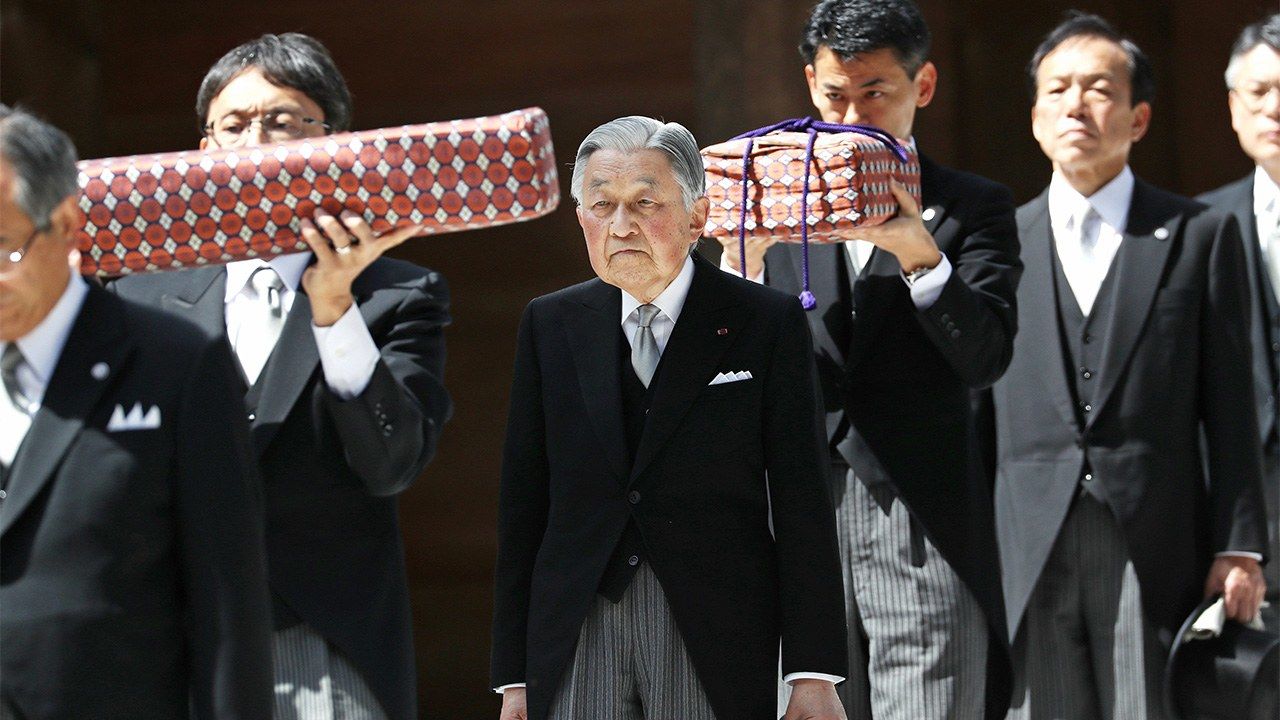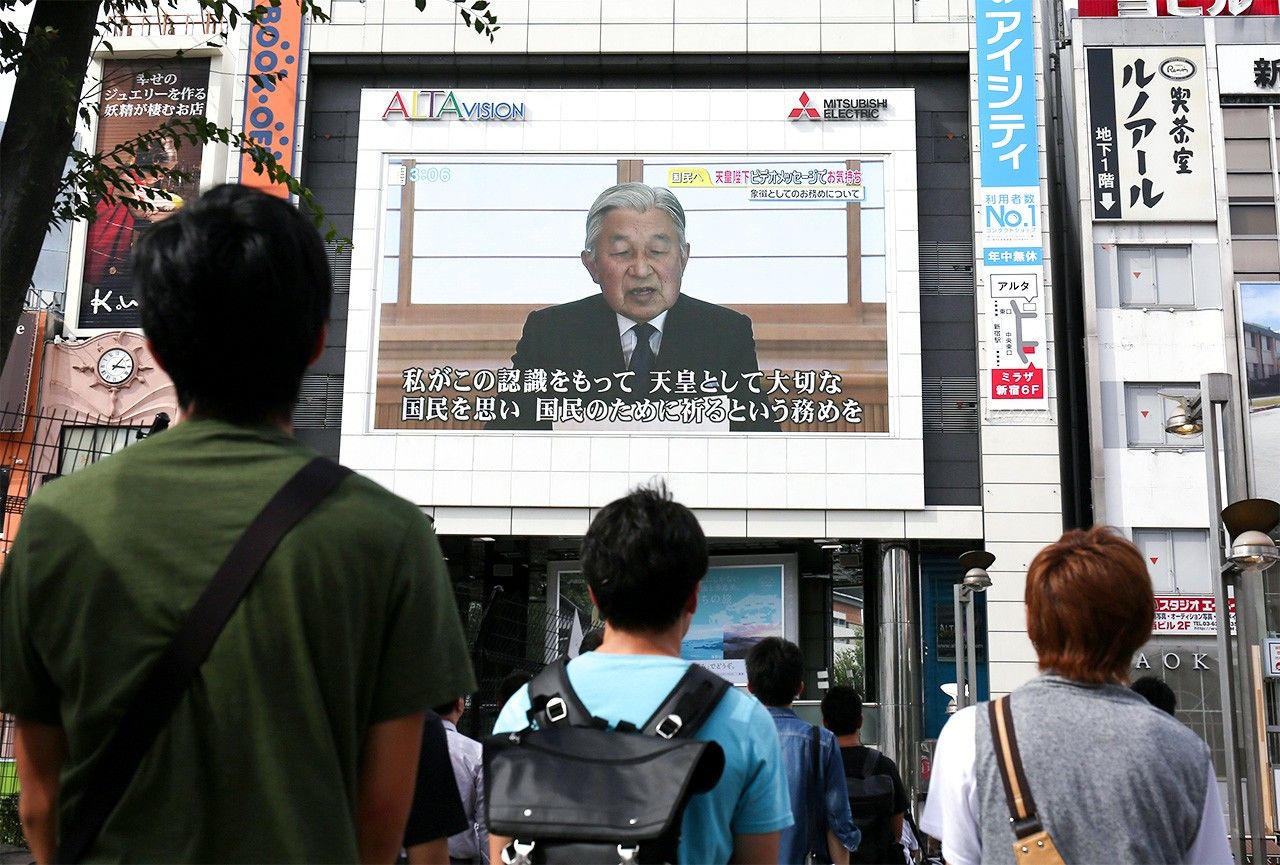
Imperial Abdication a Return to Tradition in Japan
Society Imperial Family- English
- 日本語
- 简体字
- 繁體字
- Français
- Español
- العربية
- Русский
A Shock to the People
Just over 30 years ago, I was present at the Imperial Palace for the start of the Heisei era in early 1989, but I never imagined the period would end with the emperor’s abdication. In an autumn 2018 survey by the Yomiuri Shimbun, respondents picked the decision in the previous year to create special legislation making the imperial abdication possible as the biggest news story related to the imperial household during the era. This demonstrates what a shock it was to the Japanese people.
As there were no provisions for abdication before the 2017 legislation, the question came under discussion on a number of occasions in the postwar Diet. The government and Imperial Household Agency gave three main reasons for not allowing abdication: undesirable historical precedents of retired emperors continuing to hold power, the possibility of emperors being forced to abdicate against their will, and the potential for emperors to retire to suit their own purposes, without considering others. Many citizens agreed with these sentiments.
However, in August 2016, in the twenty-eighth year of his reign, Emperor Akihito released a video message expressing his desire to pass the throne to his son Naruhito, the crown prince. The use of the media to seek the understanding of the people directly drew comparisons to his father’s famous 1945 broadcast announcing surrender at the end of World War II. The difference between hearing government and IHA representatives speaking in the Diet and being addressed by the emperor himself shook many listeners in their beliefs.

Emperor Akihito’s video message is relayed on a giant screen in Shinjuku, Tokyo, on August 8, 2016.
Persuasive Words
Built on the foundations of his long efforts to form a relationship with the country’s citizens, the emperor’s speech was powerfully persuasive. “When I consider that my fitness level is gradually declining, I am worried that it may become difficult for me to carry out my duties as the symbol of the State with my whole being as I have done until now. . . . When the Emperor has ill health and his condition becomes serious, I am concerned that, as we have seen in the past, society comes to a standstill and people’s lives are impacted in various ways. . . . It is my hope that by thoroughly reflecting on our country’s long history of emperors, the Imperial Family can continue to be with the people at all times . . . and that the duties of the Emperor as the symbol of the State can continue steadily without a break.”
Within the message, he noted that “under the Constitution, the Emperor does not have powers related to government.” He was concerned that if his words encouraged amendment of existing laws or the creation of new legislation, it might be blocked as unconstitutional. Yet he received support for his reasoning that abdication would be better for the Japanese people. Newspaper polls showed overwhelming backing from around 90% of respondents for the early imperial succession.
The Meiji Shift Away from Abdication
Emperor Akihito has been energetic in his role as a symbol of the state during the 30 years of his reign, performing such activities as paying visits to disaster areas and commemorating the war dead. He has also made great efforts to reduce the excessive security surrounding him to decrease the distance between himself and the people. He has dedicated himself to many issues and reforms, the last of which, I believe, has been revision of the imperial system. Near the beginning of his video message, he said: “While, being in the position of the Emperor, I must refrain from making any specific comments on the existing Imperial system, I would like to tell you what I, as an individual, have been thinking about.”
He has often suggested that emperors have traditionally worked in a symbolic role for the benefit of citizens, and have had little involvement in politics. In fact, the great power that was accorded to emperors as Japan rushed to modernization after the Meiji Restoration in 1868 represented a break with longstanding tradition. The greatest shift from the former imperial system came with the removal of abdication as a possible path for emperors with the establishment of the Meiji Constitution and the former Imperial House Law toward the end of the nineteenth century.
A plan to allow abdication was considered while the imperial law was being drawn up, but Japan’s first prime minister, Itō Hirobumi, opposed it, so the provision was removed. He worried that if the emperor was made to abdicate by whoever was in power, the imperial family would split, causing chaos, and the newly modern state of Japan would become unstable. Itō believed that if the emperor was seriously ill to the point that he could not govern, it would be better to appoint a regent. This was how the emperor-for-life system was introduced.
In 1921, after Emperor Taishō’s poor health meant that he was no longer able to discharge his duties, his son Hirohito served as regent for five years. Because of this precedent, many citizens became accustomed to the idea of a regent acting for an incapacitated emperor in his old age.
Solving the Problem Himself
Under the postwar Constitution, the emperor returned to a symbolic, nonpolitical role, but the issue of abdication remained. The question of Emperor Hirohito (posthumously Shōwa) abdicating was bound up with discussions over war guilt during the Allied Occupation, so it became a difficult topic to bring up after Japan regained its sovereignty in 1952. Although the Diet did come to consider the matter later in his reign, by the time his son Akihito started to consider the possibility of abdication during his own reign, it seemed to have once again become hard for politicians or citizens to bring up. He realized he would have to solve the problem himself, which is why I believe he took the unusual step of talking directly to the people.
With his words, “the Emperor continues to be the Emperor till the end of his life, even though he is unable to fully carry out his duties,” he showed his lack of support for the regency system as a solution. In his vision of the symbolic role, it is meaningless for the emperor to continue if he cannot work for the people, and when he can no longer perform his duties, he should step down. This penetrating view brought an end to the historically anomalous lifelong reign system for emperors.
Burial Choices
Three years before the abdication question went public, Emperor Akihito introduced another reform. In 2013, the IHA published a document giving the imperial couple’s views on their mausoleum and funeral rites. They expressed a desire to be laid to rest alongside each other in a simpler mausoleum than his predecessors, and to be cremated, rather than interred as previous emperors had been.
The idea of the emperor being cremated was particularly startling for the Japanese public. Akihito expressed the view that it had become standard in Japanese society, and that there were historical precedents for both cremation of emperors and empresses, as well as burial. It was a proposal and decision that only the emperor could make himself, with the aim of reducing the burden on citizens.
I learned from an imperial chamberlain who had long served Emperor Shōwa that the greatest duty of emperors is to pass on imperial tradition to their successors. It seems obvious, but I felt that I had understood the secret of preserving the world’s oldest continuous monarchy. Akihito will become the fifty-ninth emperor to abdicate his position. The fact that so many emperors have done so shows that, even with a few exceptions, it has been a highly effective system for ensuring that tradition continues to the succeeding generation.
Once we enter the Reiwa era on May 1 this year, numerous Japanese citizens are likely to want to follow the activities of the retired emperor and empress—positions full of novelty to anyone now living. There is a sense of wishing for an enjoyable, quiet retirement for the imperial couple, yet I am sure they will remain in the spotlight.
(Originally written in Japanese. Banner photo: Emperor Akihito, accompanied by the sword and jewel from the imperial regalia, visits the shrine Ise Jingū in Mie Prefecture on April 18, 2019, to report his abdication to the imperial family’s ancestral deities. © Jiji.)